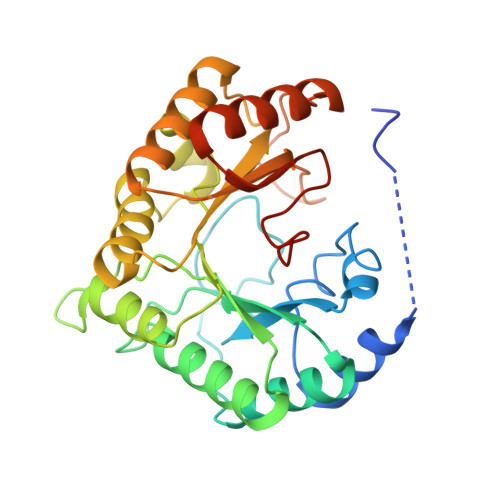Structures of lipoyl synthase reveal a compact active site for controlling sequential sulfur insertion reactions.
Harmer, J.E., Hiscox, M.J., Dinis, P.C., Fox, S.J., Iliopoulos, A., Hussey, J.E., Sandy, J., Van Beek, F.T., Essex, J.W., Roach, P.L.(2014) Biochem J 464: 123-133
- PubMed: 25100160
- DOI: https://doi.org/10.1042/BJ20140895
- Primary Citation of Related Structures:
4U0O, 4U0P - PubMed Abstract:
Lipoyl cofactors are essential for living organisms and are produced by the insertion of two sulfur atoms into the relatively unreactive C-H bonds of an octanoyl substrate. This reaction requires lipoyl synthase, a member of the radical S-adenosylmethionine (SAM) enzyme superfamily. In the present study, we solved crystal structures of lipoyl synthase with two [4Fe-4S] clusters bound at opposite ends of the TIM barrel, the usual fold of the radical SAM superfamily. The cluster required for reductive SAM cleavage conserves the features of the radical SAM superfamily, but the auxiliary cluster is bound by a CX4CX5C motif unique to lipoyl synthase. The fourth ligand to the auxiliary cluster is an extremely unusual serine residue. Site-directed mutants show this conserved serine ligand is essential for the sulfur insertion steps. One crystallized lipoyl synthase (LipA) complex contains 5'-methylthioadenosine (MTA), a breakdown product of SAM, bound in the likely SAM-binding site. Modelling has identified an 18 Å (1 Å=0.1 nm) deep channel, well-proportioned to accommodate an octanoyl substrate. These results suggest that the auxiliary cluster is the likely sulfur donor, but access to a sulfide ion for the second sulfur insertion reaction requires the loss of an iron atom from the auxiliary cluster, which the serine ligand may enable.
- *Department of Chemistry, University of Southampton, Highfield, Southampton SO17 1BJ, U.K.
Organizational Affiliation:



















